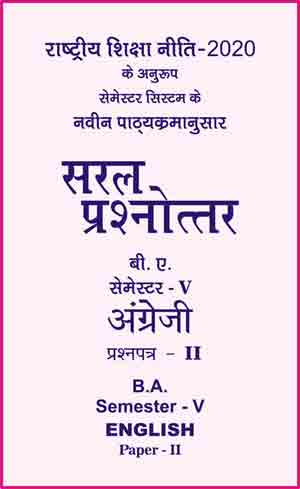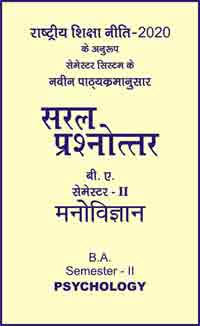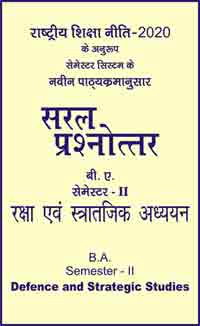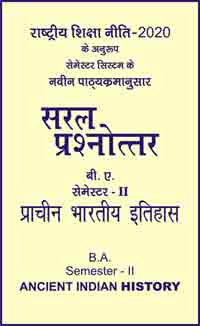|
बी ए - एम ए >> बीए सेमेस्टर-5 पेपर-2 अंग्रेजी बीए सेमेस्टर-5 पेपर-2 अंग्रेजीसरल प्रश्नोत्तर समूह
|
5 पाठक हैं |
|||||||
बीए सेमेस्टर-5 पेपर-2 अंग्रेजी - सरल प्रश्नोत्तर
Question- Explain literary analysis of The White Tiger by Aravind Adiga.
Answer-
The White Tiger by Aravind Adiga is a social commentary on the effects of the huge gap between the wealthy and the poor in India. This large gap creates instability that often leads to morality being compromised for individual gain. The poor are so desperate that they are willing to do almost anything to make it out of poverty. At the same time, the rich are so far removed from the plight of the poor that they become desensitized and corrupt. The point of view from which the story is told, the use of humor, the patterns of imagery, and the end of the novel emphasize the disparity in wealth and the immorality that results.
The White Tiger is told in first person from the point of view of Balram Halwai. This makes the reader feel the most connected with Balram, both because it seems like Balram is talking directly to the reader and because Balram's perspective is the only one shown. Balram was born into the extreme poverty of a rural Indian village where there are "glistening lines of sewage" in the streets. Through his job as a chauffeur to a rich man living in New Delhi, Balram is exposed both to extreme poverty and to fantastic wealth. Balram's unique perspective uncovers immorality in the servant class as well as the master class. He believes that immorality is justified at least somewhat by desperation as a result of poverty, and because the novel is written first person, the novel promotes Balram's position.
Through Balram's first person account of his own "rags to riches" story, the reader learns about wrongdoing at the top and the bottom. When Balram goes back to his village to visit his family, he complains bitterly about his family, who exploited his father for his meager salary until he died. Balram speaks matter of factly about the school teacher who steals the food and uniforms provided by the government to the village school children. "The teacher had a legitimate excuse to steal the money he said he hadn't been paid his salary in six months. He was going to undertake a Gandhian protest to retrieve his missing wages... Yet he was terrified of losing his job, because though the pay of any government job in India is poor, the incidental advantages are numerous...". This teacher is so desperate that he is driven to stealing from people just as poor or poorer than himself. As someone who is equally desperate, Balram understands this. Since Balram is the narrator, we understand it too.
Balram's feelings about the rich are conflicted. Balram's perspective as a servant to the wealthy engenders hatred for his masters, who are corrupt and arrogant. Balram's chauffeuring job brings him in close contact with his master's everyday activities, which include paying off politicians and paying large sums of money for prostitutes. While their masters sleep in huge mansions with many servants, the servants themselves sleep in basement rooms infested with cockroaches. The rich are so far removed from the situation of the poor that they no longer even think of the poor as human. When Balram receives a letter from his family, he asks to read it himself. However, the Mongoose (his master's brother) says "He won't mind [me reading his letter]. He has no sense of privacy". This desensitization allows the rich to continue to exploit everyone else. Balram's position in society, a personal servant to a wealthy man, allows him to uncover the immorality of the rich.
At the same time, Balram's perspective is one of yearning to live the life of the rich. Balram makes clear to the reader how much servants long for a way out of poverty, yet cannot find it. This desperation leads Balram himself to cheat his master by siphoning off gas for the car, taking the car to corrupt mechanics who overcharge and then split the extra with the chauffeur, and using the car as a taxi on the side when the master is away.
Besides showing the immorality at both the top and the bottom, Balram's informal, conversational firstperson account makes the story engaging. Readers feel like Balram is talking to them personally, even though the book is supposedly a series of letters addressed to the Chinese Premier.
The personal account of Balram makes the immoral choices of both the rich and the poor seem more understandable; they are the result of disparity in wealth, not general human evil.
Adiga uses dark humor frequently in The White Tiger to emphasize the immorality of the rich and the poor, Balram gives many satirical accounts of immorality he encounters. Describing voting fraud: "Balram is a vanished man, a fugitive, someone whose whereabouts are unknown to the police, right? Ha! The police know exactly where to find me. They will find me dutifully voting on election day at the voting booth...I am India's most faithful voter, and I still have not seen the inside of a voting booth". Balram mocks the rich for their extravagance and corruption, but also mocks his fellow members of the servant class for their own cruelty. When Balram goes home to visit his family, they chastise him for not sending enough money home. Balram says sarcastically, "For the first time I can remember, I got more attention than the water buffalo". Humor shows the many immoral choices the rich and the poor make due to their situation. After all, it is bad things that are funny, not good things.
The humor in The White Tiger also emphasizes how much Balram relies on humor as a coping mechanism, both to cope with the effects of the immoral choices of the rich on him and with having to make immoral choices himself. Balram had gotten his job as chauffeur to Mr. Ashok by revealing that Mr. Ashok's former driver, Ram Persad, was actually Muslim. Ram Persad had needed a job badly, so he had pretended he was Hindu and gotten a job with Mr. Ashok. When Balram told Mr. Ashok about Ram Prasad's true identity, Ram Prasad was immediately fired and Balram got Ram Persad's job. Though Balram admitted he felt bad, he was so desperate for a job, he felt he had no other choice. One day when Mr. Ashok and his wife were patronizing Balram over his faith, Balram exaggerated his beliefs and pretended to make signs of respect to all sorts of features of the landscape. He said, "They were convinced I was the most religious servant on earth. (Take that, Ram Prasad!)". Balram uses such dark questionable humor to come to terms with both the insults of the rich and the immoral choices he himself has made.
Humor in The White Tiger also seems to make the story more digestible, except for some racist and sexist humor. It is hard to read social commentaries because they expose many of the negative, immoral aspects of society. Humor might make Adiga's message more palatable.
There are many symbols and patterns of imagery in The White Tiger that emphasize the huge difference between the rich and the poor. The main image is of the poor living in the "Darkness" and the rich living in the "Light." This metaphor shows how extreme the difference between being poor and being rich is. "India is two countries in one: an India of Light, and an India of Darkness. The ocean brings Light to my country. Every place...near the ocean is well off. But [the Ganges] river brings darkness to India the black river".
The images of the Black Fort and the Chandelier are extensions of the Light/Dark imagery. The Black Fort is a huge forbidding ruin located on a hill by Balram's village. The Black Fort is a symbol of the extreme poverty that Balram is in. One day Balram gets the courage to enter the Black Fort. He says "I leaned out from the edge of the fort in the direction of my village...I spat. Again and again... Eight months later I slit Mr. Ashok's throat". Balram broke out of the Black Fort mentally when he spat on it from its the entranceway and broke out from the Black Fort physically when he killed his master and entered the "Light." The Black Fort emphasizes how desperate Balram feels.
The Chandelier is the opposite of the Black Fort. The Chandelier is the gaudy light fixture that Balram has in his new office after he murders Mr. Ashok and starts his own company in Bangalore. It represents the wealthy who Balram has joined through murdering his master and stealing his money. Balram says, "It makes me happy to see the chandelier...Let me buy all the Chandeliers I want" Balram was so desperate for wealth that he not only murdered his master, but did so in the knowledge that his master's family would take deadly revenge on his own family. "I've got no family anymore. All I've got are Chandeliers". The Chandelier also emphasizes how desperate Balram felt to get out of poverty. Balram says when he thinks of the devil he thinks of a little black figure climbing up the entranceway to a Black Fort. "I see the little man...spitting at God again and again, as I watch the black blades of the midget fan slice the light from the Chandelier again and again". Balram associates himself with the little man, who is so desperate that he will defy God and associate with the devil to break out of the cycle of poverty. The fan represents the little man and the light of the Chandelier represents the wealthy. The fan is "murdering" and "stealing from" the light of the Chandelier. Balram, represented by the fan, was in such a desperate situation that he saw murdering his master, represented by the Chandelier, as an "entrepreneurial" act.
In The White Tiger, there are many images of humans living like animals. Balram says "Let animals live like animals; let humans live like humAnswer- That's my whole philosophy in a sentence". Both the wealthy and the poor "live like animals" because they both make immoral choices, due to desensitization or desperation. Balram recognizes this; he even calls the four corrupt landlords the Raven, the Wild Boar, the Buffalo, and the Stork. Balram is also unable to "live like a human," in his case because of the poverty and desperation he was born into. Balram himself is represented by a white tiger. A teacher told Balram "The white tiger. That's what you are in this jungle". The white tiger is a rare animal, as Balram is a rare man. Balram managed to successfully break out of the cycle of poverty, but had to become a murderer to do so. The poor of India are often referred to as roosters in a rooster coop. The poor are kept in poverty despite their desperation to have a higher standard of living because to break out of the rooster coop would involve acting very immorally. Balram says, "Can a man a man break out of the coop? What if one day, for instance, a driver took his employer's money and ran... Only a man who is prepared to see his family destroyed hunted, beaten...can break out of the coop". The metaphor of the Rooster Coop emphasizes how immorality is encouraged through the large gap between the rich and the poor,
The end of The White Tiger emphasizes the immorality that results from vast disparity in wealth but also hints that things will improve. Balram murdered, stole, and sacrificed his family to break out of the servant class. He also bribed the police to help him set up his new chauffeuring business for call center workers in Bangalore. In many ways Balram acted just like his former master Mr. Ashok as symbolized by Balram taking the name "Ashok" when he moved to Bangalore. However, Balram changed when he moved to Bangalore and became a member of the upper class himself. When one of Balram's drivers, Mohammad Asif, accidentally killed a poor young boy while driving, Balram called the police. The police then cleared Mohammad Asif of any charges because of Balram's bribes, but Balram himself assumed responsibility for the accident and went to the family of the boy. He offered them money and a job for their older son at his company. Though Balram participated in corruption and certainly founded his company immorally, he tried to compensate the family of the boy and assumed responsibility for the accident. Balram also says, "Once I was a driver to a master, but now I am at master of drivers. I don't treat them like servants I don't slap, or bully, or mock anyone. I don't insult any of them by calling them my 'family,' either. They're my employees, I'm their boss, that's all". Though the ending is not a perfectly happy ending, it seems hopeful. Balram makes it out of poverty, but he does not become desensitized and distanced from where he came from, and this allows him to act morally more often. He says, "Now, despite my amazing success story, I don't want to lose contact with the places where I got my real education in life".
The difference between the rich and the poor, Balram explains, is that the poor have no choice but to be immoral while the rich do have a choice. "Allow me to illustrate the differences between Bangalore and Laxmangarh. Understand...it is not as if you come to Bangalore and find that everyone is moral and upright here. This city has its share of thugs and politiciAnswer- It's just that here, if a man wants to be good, he can be good. In Laxmangarh, he doesn't even have this choice. In the future, Balram says Bangalore "might turn out to be a decent city where humans can live like humans and animals can live like animals". The last lines of the novel accentuate again the justification of immorality through desperation. Balram says "I'll never say I made a mistake that night in Delhi when I slit my master's throat... It was worthwhile to know, just for a day, just for an hour, just for a minute, what it means not to be a servant".
The White Tiger by Aravind Adiga is a darkly humorous social commentary on modern India. In his novel, Adiga shows how a large disparity in wealth can move people to make immoral choices whether they are wealthy or poor. However, the novel ends on an optimistic note, with Balram both making it out of poverty and being able to make more moral choices. As Balram would say, ha!
|
|||||
- Question- Discuss in detail the development of English novel from the eighteenth century to the Modern Age.
- Question- What do you understand by Novel? What are the elements which are to considered in plot construction.
- Question- Write a note on characterization of a novel. How much is it important for development of a novel?
- Question- Write a short note on narrative technique of a novel.
- Question- Write a note on the elements of a short story.
- Question- Write a note on Fielding's plot construction.
- Question- Write a note on Fielding's characterisation.
- Question- Define plot. What are the qualities of an ideal plot ?
- Question- Write a short note on the plot construction of a novel.
- Question- What is the difference between Flat Character and Round Character?
- Question- Write a short note on the characterization of a novel.
- Question- Write a short note on narrative technique of a novel.
- Question- What is a short story? What is the difference between a short story and a novel?
- Question- What is a picaresque novel? Who are the main exponents of the picaresque novel?
- Question- What is a historical novel? What is the difference between history and a historical novel? Name a few historical novelists and their creation.
- Question- What do you know about the Gothic novel?
- Question- Write a note on Epistolary novel.
- Question- Write a note on the Regional novel.
- Question- Point out the chief characteristics of the Picaresque novel.
- Question- Point out the chief characteristics of the historical novel.
- Question- Write an essay on Sir Walter Scott's contribution to historical novel.
- Question- Point out the chief characteristics of Gothic novel.
- Question- Point out the chief characteristics of the Regional novel.
- Question- What is a regional novel? Name a few novelists of this genre and their novels.
- Question- What is a Picaresque novel?
- Question- What do you know about Historical novel?
- Question- What do you know about Gothic novel?
- Question- Examine the merits of Sir Walter Scott as a Historical novelist.
- Question- What do you mean by domestic novel?
- Question- What do you mean by the Stream of consciousness? Who. coined the term?
- Question- What is a Epistolary novel?
- Question- What do you know about the Regional novel?
- Question- Trends in 20th and 21st Century Fiction Discuss as a sub-genre of crime fiction and mystery.
- Question- Define utopian fiction. Discuss its history and origin.
- Question- What is campus novel? Explain its history and development.
- Question- Write a note on Detective novel.
- Question- Write a note on Science fictions.
- Question- Write a note on Meta fiction.
- Question- Define mythology. Explain the rise of mythological fiction in India.
- Question- What is space fiction? Discuss its characteristics and example.
- Question- Define chick lit. Discuss its characteristics and example.
- Question- Define junk fiction. Explain its characteristics and types of junk fiction.
- Question- Write a short note on detective novel.
- Question- Write short note on Science fiction.
- Question- What is Meta fiction?
- Question- What is Science Fiction?
- Question- What is utopian fiction?
- Question- Why are campus novels important? What kind of characters are in campus novels?
- Question- What is dystopian fiction?
- Question- Discuss feminism in mythological fiction.
- Question- Why are campus novels important? What kind of characters are in campus novels?
- Question- What is chic lit fiction?
- Question- Write a note on the life and works of Charles Dickens.
- Question- Write a note on Charles Dickens as a novelist.
- Question- Write a note on the development of English novel up to Dickens.
- Question- Write a note on Dicken's social criticism. What was Dickens' attitude toward various social evils of the day?
- Question- Describe Dickens as a representative of his age.
- Question- Write a note on Dickens as a social reformer.
- Question- Write a note on the social background of Dickens.
- Question- Write a note on Dickens's contribution to English novel.
- Question- Discuss symbolism as a structural elements in A Tale of two cities.
- Question- Discuss Dickens's art of characterization in the novel "A Tale of Two Cities".
- Question- What is meant by criticism of life? What is the 'vision of life"? Point out the criticism and vision of life in A Tale of Two Cities.
- Question- Write a note on the blend of realism and idealism in the novels of Dickens.
- Question- "Dickens' characters are both types and individuals.” Discuss.
- Question- Write a note on Dickens as a satirist.
- Question- What is the significance of the name "Jacques" in A Tale of Two Cities?
- Question- In Book 2, Chapter 21 of A Tale of Two Cities, what is happening in France that upsets Mr. Jarvis Lorry?
- Question- Write the life of Thomas Hardy and about his career.
- Question- What are the three phases of Hardy's writing? What were the issues he dealt with in those three phases?
- Question- Write short notes on the major characters of the novel, and show how Hardy develops these characters in the course of the novel.
- Question- Who is the heroine of 'Far From the Madding Crowd"? How doy o you justify her position as the heroine?
- Question- Explain the tragic vision of Hardy in Far From the Mad ding Crowd.
- Question- Why does Bathsheba reject Gabriel's proposal at the start of the novel?
- Question- How is sexual desire portrayed in the novel?
- Question- How was Oak's life saved by Bathsheba?
- Question- How was Oak completely ruined?
- Question- Describe the feast after sheep-shearing.
- Question- How are Oak and Bathsheba ultimately a happy couple?
- Question- Discuss Jane Austen as a realist.
- Question- Point out Jane Austen's contribution to the English novel.
- Question- Write a note on characterisation of Jane Austen with special reference to 'Pride and Prejudice'.
- Question- Is there artistic detachment in Jane Austen ? Write a brief note in support to your view with illustrations.
- Question- Sketch the character of Fitzwilliam Darcy.
- Question- Sketch the character of George Wickham.
- Question- Do you agree with the view that the novel 'Pride and Prejudice' revolves around two themes of 'Pride and Prejudice'? Give reasons for your answer?
- Question- Write an essay on the sequence of events in 'Pride and Prejudice'?
- Question- Write a note on Life Sketch of George Eliot Life Sketch of George Eliot
- Question- Discuss the humour elements in George Eliot's The Mill on the Floss.
- Question- Critically examine the artistic and the philosophic dimensions of the ending of The Mill on the Floss in the light of the view of the individual and society presented in the novel.
- Question- Compare and contrast Maggie's love for Philip, Stephen, and Tom.
- Question- Describe the thematic import of Maggie's decision to relinquish Stephen.
- Question- Compare and contrast Tom and Maggie. How much are their respective successes and failures a function of gender and how much a function of their distinct characteristics?
- Question- Compare and contrast Tom and Mr. Tulliver. Why does Tom succeed where Mr. Tulliver failed?
- Question- Write a note on life kketch of Toni Morrison.
- Question- Discuss the narrative strategies used by the writer in The Bluest Eye.
- Question- Discuss the narrative structure of the novel. Why might Morrison have chosen to present the events in a non- chronological way?
- Question- What does the title of The Bluest Eye mean?
- Question- How are Pecola Breedlove and Maureen Peal foils to one another?
- Question- The Bluest Eye uses multiple narrators, including Claudia as a child, Claudia as an adult, and an omniscient narrator. Which narrative point of view doyou think is most central to the novel and why?
- Question- Who do you think is the most sympathetic character in the novel and why?
- Question- The Bluest Eye is a novel about racism, and yet there are relatively few instances of the direct oppression of black people by white people in the book. Explain how racism functions in the story.
- Question- Write a note on Life Sketch of The Harper Lee.
- Question- Analyze the childhood world of Jem, Scout, and Dill and their relationship with Boo Radley in Part One.
- Question- What is Atticus's relationship to the rest of Maycomb? What is his role in the community?
- Question- Discuss the role of family in To Kill a Mockingbird, paying close attention to Aunt Alexandra.
- Question- Discuss the author's descriptions of Maycomb. What is the town's role in the novel? Analyze the author's treatment of Boo Radley. What is his role in the novel?
- Question- Discuss Atticus's parenting style. What is his relationship to his children like? How does he seek to instill conscience in them?
- Question- Identify Atticus Finch, Jean Louise (Scout) Finch, Jem Finch, Maycomb, Calpurnia, Charles Baker (Dill) Harris, The Radley Place, Stephanie Crawford, Arthur (Boo) Radley, Miss Caroline Fisher, Walter Cunningham, and Burris Ewell.
- Question- Why did Mr. Cunningham's mob leave?
- Question- In Chapter 2 of To Kill a Mockingbird what does Miss Caroline, Scout's first-grade teacher, represent?
- Question- In Chapter 6 of To Kill a Mockingbird why is Jem is determined to retrieve his pants from the fence despite the danger of meeting up with Nathan Radley?
- Question- What is the significance of the title To Kill a Mockingbird according to Atticus's reasoning in Chapter 10?
- Question - Comment upon the role of the lions in The Old Man And The Sea.
- Question- Comment upon the symbolic role played by Di Maggio in the novel "The Old Man And The Sea'...
- Question- Comment upon the arm-wrestling episode in the novel 'The Old Man and The Sea'.
- Question- Comment upon the marlin separating episode in the novel "The Old Man and The Sea".
- Question- Write a note on the major themes of the novel The Old Man and The Sea'.
- Question- Write a brief note on The Old Man And The Sea' as a tragedy.
- Question- Which claims your attention more in The Old Man And The Sea' its narrative or allegory?
- Question- The hero of the novel "The Old Man And The Sea' is really a Christfigure. Comment.
- Question- Write a brief note on Hemingway hero or the autobiographical hero.
- Question- In the fight of the old man against the giant fish what we see is a "battle of attrition". Comment.
- Question- Write a note on Life Sketh of John Ernst Steinbeck.
- Question- Analyze Tom Joad's growth throughout the novel. Despite the fact that Tom is not a young boy, does the novel have the characteristics of a bildungsroman, or coming-of-age story?
- Question- Discuss the development of Tom Joad as a character. How does he grow throughout the book? What effects do Jim Casy's imprisonment and death have on his development?
- Question-What themes related to family are in The Grapes of Wrath?
- Question- How does the erosion described in Chapter 1 of The Grapes of Wrath relate to the Bank monster described in Chapter 5?
- Question- How do the roles of Ma and Pa differ in the Joad family in The Grapes of Wrath?
- Question- In The Grapes of Wrath how is the Gila monster described in Chapter 13 comparable the Bank monster?
- Question- What biblical allusions does John Steinbeck include in The Grapes of Wrath and how does he use them?
- Question- How do the roles of Ma Joad and Pa Joad within the family change in The Grapes of Wrath?
- Question- In The Grapes of Wrath, why does the Joad family deteriorate after the Joads leave Oklahoma?
- Question- Write a note on Life Sketch of Aravind Adiga
- Question- Discuss plot of the novel The White Tiger.
- Question- Explain literary analysis of The White Tiger by Aravind Adiga.
- Question- Critical analysis of the novel The White Tiger written by Aravind Adiga.
- Question- What is Balram's attitude toward religion? How does this develop throughout the novel?
- Question- How does this portrayal of India differ from more typical literary depictions of India?
- Question- Why does Balram choose to address his narrative to the Premier of China? How would the story have been different without this framing device?
- Question- Discuss Balram's many names throughout the novel, and how each one represents an aspect of him.
- Question- What does Balram's experience in Bangalore reveal about the Indian economy in an increasingly globalized world?
- Question- Attempt critical analysis of the novel 'Dalits, Dynasty and She' by Sanjay Chitranshi.
- Question- Explain the plot of the novel 'Dalits, Dynasty and She 'written by Sanjay Chitranshi.
- Question- Discuss the Novel 'Dalits, Dynasty and She' by Sanjay Chitranshi.
- Question- Who was Shanti Devi?
- Question- Write a' character sketch of Ram Chandra.
- Question- Write a note on Life Sketch of Sudha Murty.
- Question- What are the major themes of the novel "Dollar Bahu"?
- Question- Discuss how the notion of self sacrifice is exclusively attributed to a particular gender in Indian society. How they thrive through the difficult situation in life when they are implanted to a new atmosphere.
- Question- Write a note on the title "Dollar Bahu?".
- Question- Write a note on the end of the novel "Dollar Bahu".
- Question- Discuss the central theme of Dollar Bahu.














